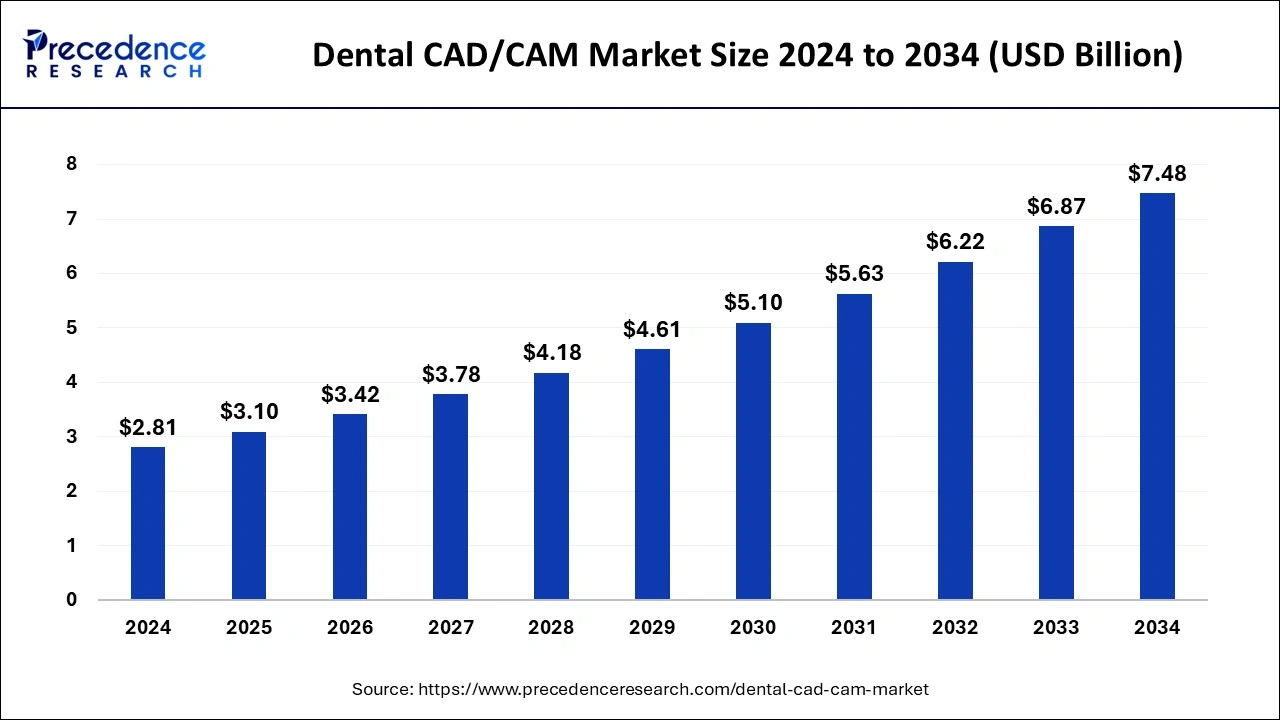The Dental CAD/CAM (Computer-Aided Design/Computer-Aided Manufacturing) market has witnessed significant growth in recent years, driven by advancements in dental technology and the increasing demand for customized dental solutions. Dental CAD/CAM systems enable dentists and dental technicians to design and manufacture dental prostheses, including crowns, bridges, veneers, and implants, with precision and efficiency. These systems utilize computer software and hardware to streamline the design and production processes, leading to improved accuracy, reduced turnaround times, and enhanced patient satisfaction. The market encompasses a wide range of products and services offered by leading manufacturers, dental laboratories, and service providers globally.
Get a Sample: https://www.precedenceresearch.com/sample/3946
Growth Factors:
Several key factors contribute to the growth of the Dental CAD/CAM market. Firstly, the rising prevalence of dental disorders, such as tooth decay, periodontal diseases, and dental trauma, drives the demand for restorative and prosthetic dental treatments. Dental CAD/CAM technology enables the fabrication of high-quality dental restorations that closely resemble natural teeth, thereby addressing the increasing need for aesthetic and functional solutions. Additionally, the growing adoption of digital dentistry practices and the integration of CAD/CAM systems into dental clinics and laboratories enhance workflow efficiency and treatment outcomes. Moreover, technological advancements, such as improved scanning and milling capabilities, expanded material options, and enhanced software functionalities, contribute to the market’s growth by enabling more precise and versatile dental restorations.
Dental CAD/CAM Market Scope
| Report Coverage |
Details |
| Growth Rate from 2024 to 2033 |
CAGR of 10.46% |
| Global Market Size in 2023 |
USD 2.54 Billion |
| Global Market Size by 2033 |
USD 6.87 Billion |
| U.S. Market Size in 2023 |
USD 690 Million |
| U.S. Market Size by 2033 |
USD 1,880 Million |
| Base Year |
2023 |
| Forecast Period |
2024 to 2033 |
| Segments Covered |
By Type, By Component, and By End-user |
| Regions Covered |
North America, Europe, Asia-Pacific, Latin America, and Middle East & Africa |
Dental CAD/CAM Market Dynamics
Drivers:
Several drivers propel the expansion of the Dental CAD/CAM market. One significant driver is the increasing demand for aesthetic dental treatments driven by rising consumer awareness and the desire for improved smile aesthetics. CAD/CAM technology allows for the creation of highly aesthetic and natural-looking dental restorations, catering to patients’ aesthetic preferences and boosting the adoption of cosmetic dentistry procedures. Furthermore, the growing geriatric population worldwide, coupled with the prevalence of age-related dental issues, fuels the demand for restorative dental treatments and prostheses. CAD/CAM systems offer tailored solutions that address the specific needs of elderly patients, such as durable and comfortable dentures and implants, thereby driving market growth. Additionally, the shift towards digital workflows and the emphasis on efficiency and precision in dental practice management contribute to the widespread adoption of CAD/CAM technology among dental professionals.
Restraints:
Despite its significant growth prospects, the Dental CAD/CAM market faces certain challenges and restraints. One key restraint is the high initial investment required for acquiring and implementing CAD/CAM systems, which may deter small dental practices and laboratories with limited financial resources. Additionally, the complexity of CAD/CAM technology and the need for specialized training and expertise pose barriers to adoption among some dental professionals. Moreover, concerns regarding the accuracy and reliability of CAD/CAM-produced restorations, particularly in complex cases or with challenging materials, may hinder widespread acceptance of these systems. Furthermore, regulatory requirements and standards governing the use of CAD/CAM technology in dentistry, including certification and quality assurance protocols, add complexity and compliance burdens for manufacturers and service providers.
Opportunity:
Despite the challenges, the Dental CAD/CAM market presents significant opportunities for growth and innovation. One major opportunity lies in the integration of artificial intelligence (AI) and machine learning algorithms into CAD/CAM systems, enabling automated design optimization, material selection, and quality control processes. AI-driven CAD/CAM solutions can enhance efficiency, accuracy, and predictability in dental restoration workflows, leading to improved treatment outcomes and patient satisfaction. Additionally, the expansion of digital dentistry ecosystems and the development of cloud-based CAD/CAM platforms offer opportunities for remote collaboration, data sharing, and tele-dentistry services, particularly in underserved regions or areas with limited access to specialized dental care. Furthermore, the customization and personalization capabilities of CAD/CAM technology enable the development of patient-specific dental solutions, catering to individual anatomical and aesthetic requirements, thereby driving market growth and differentiation.
Read Also: Vascular Closure Devices Market Size to Rise USD 3.30 Bn by 2033
Region Insights:
The Dental CAD/CAM market exhibits regional variations in terms of adoption rates, market dynamics, and competitive landscape. North America represents a significant market share, driven by the presence of established CAD/CAM manufacturers, advanced dental infrastructure, and high healthcare expenditure. The region benefits from early technology adoption and widespread acceptance of digital dentistry practices among dental professionals and patients. Europe also holds a considerable market share, fueled by the growing demand for cosmetic dentistry procedures and the emphasis on quality and precision in dental restorations. Moreover, Asia Pacific emerges as a rapidly growing market, propelled by increasing healthcare investments, rising disposable incomes, and expanding dental tourism. Countries like China, India, and Japan witness a surge in CAD/CAM adoption, driven by the modernization of dental laboratories, the growing dental implant market, and the rising awareness of oral health among the population. Additionally, Latin America and the Middle East & Africa regions offer untapped potential for market expansion, driven by improving healthcare infrastructure, rising dental care expenditures, and the growing prevalence of dental disorders. However, challenges such as regulatory barriers, economic uncertainties, and cultural preferences may impact market growth in these regions. Overall, the Dental CAD/CAM market presents diverse opportunities and challenges across different geographical regions, necessitating tailored strategies and partnerships to capitalize on emerging trends and market dynamics.


